Class 8: Maths Chapter 8 solutions. Complete Class 8 Maths Chapter 8 Notes.
Contents
RD Sharma Solutions for Class 8 Maths Chapter 8–Division of Algebraic Expressions
RD Sharma 8th Maths Chapter 8, Class 8 Maths Chapter 8 solutions
EXERCISE 8.1 PAGE NO: 8.2
1. Write the degree of each of the following polynomials:
(i) 2x3 + 5x2 – 7
(ii) 5x2 – 3x + 2
(iii) 2x + x2 – 8
(iv) 1/2y7 – 12y6 + 48y5 – 10
(v) 3x3 + 1
(vi) 5
(vii) 20x3 + 12x2y2 – 10y2 + 20
Solution:
(i) 2x3 + 5x2 – 7
We know that in a polynomial, degree is the highest power of the variable.
The degree of the polynomial, 2x3 + 5x2 – 7 is 3.
(ii) 5x2 – 3x + 2
The degree of the polynomial, 5x2 – 3x + 2 is 2.
(iii) 2x + x2 – 8
The degree of the polynomial, 2x + x2 – 8 is 2.
(iv) 1/2y7 – 12y6 + 48y5 – 10
The degree of the polynomial, 1/2y7 – 12y6 + 48y5 – 10 is 7.
(v) 3x3 + 1
The degree of the polynomial, 3x3 + 1 is 3
(vi) 5
The degree of the polynomial, 5 is 0 (since 5 is a constant number).
(vii) 20x3 + 12x2y2 – 10y2 + 20
The degree of the polynomial, 20x3 + 12x2y2 – 10y2 + 20 is 4.
2. Which of the following expressions are not polynomials?
(i) x2 + 2x-2
(ii) √(ax) + x2 – x3
(iii) 3y3 – √5y + 9
(iv) ax1/2 + ax + 9x2 + 4
(v) 3x-3 + 2x-1 + 4x + 5
Solution:
(i) x2 + 2x-2
The given expression is not a polynomial.
Because a polynomial does not contain any negative powers or fractions.
(ii) √(ax) + x2 – x3
The given expression is a polynomial.
Because the polynomial has positive powers.
(iii) 3y3 – √5y + 9
The given expression is a polynomial.
Because the polynomial has positive powers.
(iv) ax1/2 + ax + 9x2 + 4
The given expression is not a polynomial.
Because a polynomial does not contain any negative powers or fractions.
(v) 3x-3 + 2x-1 + 4x + 5
The given expression is not a polynomial.
Because a polynomial does not contain any negative powers or fractions.
3. Write each of the following polynomials in the standard from. Also, write their degree:
(i) x2 + 3 + 6x + 5x4
(ii) a2 + 4 + 5a6
(iii) (x3 – 1) (x3 – 4)
(iv) (y3 – 2) (y3 + 11)
(v) (a3 – 3/8) (a3 + 16/17)
(vi) (a + 3/4) (a + 4/3)
Solution:
(i) x2 + 3 + 6x + 5x4
The standard form of the polynomial is written in either increasing or decreasing order of their powers.
3 + 6x + x2 + 5x4 or 5x4 + x2 + 6x + 3
The degree of the given polynomial is 4.
(ii) a2 + 4 + 5a6
The standard form of the polynomial is written in either increasing or decreasing order of their powers.
4 + a2 + 5a6 or 5a6 + a2 + 4
The degree of the given polynomial is 6.
(iii) (x3 – 1) (x3 – 4)
x6 – 4x3 – x3 + 4
x6 – 5x3 + 4
The standard form of the polynomial is written in either increasing or decreasing order of their powers.
x6 – 5x3 + 4 or 4 – 5x3 + x6
The degree of the given polynomial is 6.
(iv) (y3 – 2) (y3 + 11)
y6 + 11y3 – 2y3 – 22
y6 + 9y3 – 22
The standard form of the polynomial is written in either increasing or decreasing order of their powers.
y6 + 9y3 – 22 or -22 + 9y3 + y6
The degree of the given polynomial is 6.
(v) (a3 – 3/8) (a3 + 16/17)
a6 + 16a3/17 – 3a3/8 – 6/17
a6 + 77/136a3 – 48/136
The standard form of the polynomial is written in either increasing or decreasing order of their powers.
a6 + 77/136a3 – 48/136 or -48/136 + 77/136a3 + a6
The degree of the given polynomial is 6.
(vi) (a + 3/4) (a + 4/3)
a2 + 4a/3 + 3a/4 + 1
a2 + 25a/12 + 1
The standard form of the polynomial is written in either increasing or decreasing order of their powers.
a2 + 25a/12 + 1 or 1 + 25a/12 + a2
The degree of the given polynomial is 2.
EXERCISE 8.2 PAGE NO: 8.4
Divide:
1. 6x3y2z2 by 3x2yz
Solution:
We have,
6x3y2z2 / 3x2yz
By using the formula an / am = an-m
6/3 x3-2 y2-1 z2-1
2xyz
2. 15m2n3 by 5m2n2
Solution:
We have,
15m2n3 / 5m2n2
By using the formula an / am = an-m
15/5 m2-2 n3-2
3n
3. 24a3b3 by -8ab
Solution:
We have,
24a3b3 / -8ab
By using the formula an / am = an-m
24/-8 a3-1 b3-1
-3a2b2
4. -21abc2 by 7abc
Solution:
We have,
-21abc2 / 7abc
By using the formula an / am = an-m
-21/7 a1-1 b1-1 c2-1
-3c
5. 72xyz2 by -9xz
Solution:
We have,
72xyz2 / -9xz
By using the formula an / am = an-m
72/-9 x1-1 y z2-1
-8yz
6. -72a4b5c8 by -9a2b2c3
Solution:
We have,
-72a4b5c8 / -9a2b2c3
By using the formula an / am = an-m
-72/-9 a4-2 b5-2 c8-3
8a2b3c5
Simplify:
7. 16m3y2 / 4m2y
Solution:
We have,
16m3y2 / 4m2y
By using the formula an / am = an-m
16/4 m3-2 y2-1
4my
8. 32m2n3p2 / 4mnp
Solution:
We have,
32m2n3p2 / 4mnp
By using the formula an / am = an-m
32/4 m2-1 n3-1 p2-1
8mn2p
EXERCISE 8.3 PAGE NO: 8.6
Divide:
1. x + 2x2 + 3x4 – x5 by 2x
Solution:
We have,
(x + 2x2 + 3x4 – x5) / 2x
x/2x + 2x2/2x + 3x4/2x – x5/2x
By using the formula an / am = an-m
1/2 x1-1 + x2-1 + 3/2 x4-1 – 1/2 x5-1
1/2 + x + 3/2 x3 – 1/2 x4
2. y4 – 3y3 + 1/2y2 by 3y
Solution:
We have,
(y4 – 3y3 + 1/2y2)/ 3y
y4/3y – 3y3/3y + (½)y2/3y
By using the formula an / am = an-m
1/3 y4-1 – y3-1 + 1/6 y2-1
1/3y3 – y2 + 1/6y
3. -4a3 + 4a2 + a by 2a
Solution:
We have,
(-4a3 + 4a2 + a) / 2a
-4a3/2a + 4a2/2a + a/2a
By using the formula an / am = an-m
-2a3-1 + 2a2-1 + 1/2 a1-1
-2a2 + 2a + ½
4. –x6 + 2x4 + 4x3 + 2x2 by √2x2
Solution:
We have,
(–x6 + 2x4 + 4x3 + 2x2) / √2x2
-x6/√2x2 + 2x4/√2x2 + 4x3/√2x2 + 2x2/√2x2
By using the formula an / am = an-m
-1/√2 x6-2 + 2/√2 x4-2 + 4/√2 x3-2 + 2/√2 x2-2
-1/√2 x4 + √2x2 + 2√2x + √2
5. -4a3 + 4a2 + a by 2a
Solution:
We have,
(-4a3 + 4a2 + a) / 2a
-4a3/2a + 4a2/2a + a/2a
By using the formula an / am = an-m
-2a3-1 + 2a2-1 + 1/2a1-1
-2a2 + 2a + ½
6. √3a4 + 2√3a3 + 3a2 – 6a by 3a
Solution:
We have,
(√3a4 + 2√3a3 + 3a2 – 6a) / 3a
√3a4/3a + 2√3a3/3a + 3a2/3a – 6a/3a
By using the formula an / am = an-m
√3/3 a4-1 + 2√3/3 a3-1 + a2-1 – 2a1-1
1/√3 a3 + 2/√3 a2 + a – 2
EXERCISE 8.4 PAGE NO: 8.11
Divide:
1. 5x3 – 15x2 + 25x by 5x
Solution:
We have,
(5x3 – 15x2 + 25x) / 5x
5x3/5x – 15x2/5x + 25x/5x
By using the formula an / am = an-m
5/5 x3-1 – 15/5 x2-1 + 25/5 x1-1
x2 – 3x + 5
2. 4z3 + 6z2 – z by -1/2z
Solution:
We have,
(4z3 + 6z2 – z) / -1/2z
4z3/(-1/2z) + 6z2/(-1/2z) – z/(-1/2z)
By using the formula an / am = an-m
-8 z3-1 – 12z2-1 + 2 z1-1
-8z2 – 12z + 2
3. 9x2y – 6xy + 12xy2 by -3/2xy
Solution:
We have,
(9x2y – 6xy + 12xy2) / -3/2xy
9x2y/(-3/2xy) – 6xy/(-3/2xy) + 12xy2/(-3/2xy)
By using the formula an / am = an-m
(-9×2)/3 x2-1y1-1 – (-6×2)/3 x1-1y1-1 + (-12×2)/3 x1-1y2-1
-6x + 4 – 8y
4. 3x3y2 + 2x2y + 15xy by 3xy
Solution:
We have,
(3x3y2 + 2x2y + 15xy) / 3xy
3x3y2/3xy + 2x2y/3xy + 15xy/3xy
By using the formula an / am = an-m
3/3 x3-1y2-1 + 2/3 x2-1y1-1 + 15/3 x1-1y1-1
x2y + 2/3x + 5
5. x2 + 7x + 12 by x + 4
Solution:
We have,
(x2 + 7x + 12) / (x + 4)
By using long division method
∴ (x2 + 7x + 12) / (x + 4) = x + 3
6. 4y2 + 3y + 1/2 by 2y + 1
Solution:
We have,
4y2 + 3y + 1/2 by (2y + 1)
By using long division method

∴ (4y2 + 3y + 1/2) / (2y + 1) = 2y + 1/2
7. 3x3 + 4x2 + 5x + 18 by x + 2
Solution:
We have,
(3x3 + 4x2 + 5x + 18) / (x + 2)
By using long division method

∴ (3x3 + 4x2 + 5x + 18) / (x + 2) = 3x2 – 2x + 9
8. 14x2 – 53x + 45 by 7x – 9
Solution:
We have,
(14x2 – 53x + 45) / (7x – 9)
By using long division method

∴ (14x2 – 53x + 45) / (7x – 9) = 2x – 5
9. -21 + 71x – 31x2 – 24x3 by 3 – 8x
Solution:
We have,
-21 + 71x – 31x2 – 24x3 by 3 – 8x
(-24x3 – 31x2 + 71x – 21) / (3 – 8x)
By using long division method
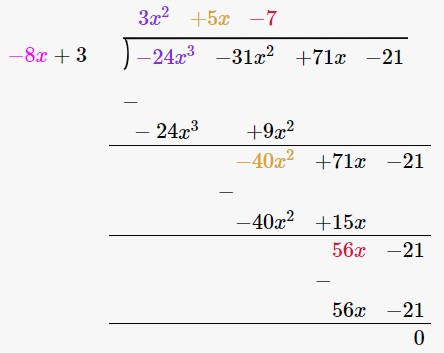
∴ (-24x3 – 31x2 + 71x – 21) / (3 – 8x) = 3x2 + 5x – 7
10. 3y4 – 3y3 – 4y2 – 4y by y2 – 2y
Solution:
We have,
(3y4 – 3y3 – 4y2 – 4y) / (y2 – 2y)
By using long division method
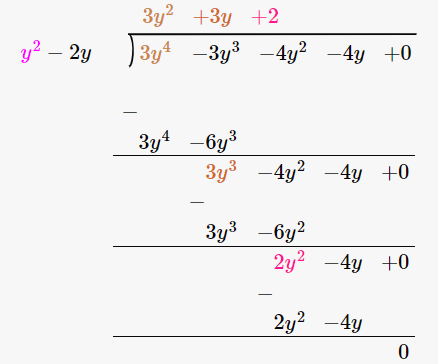
∴ (3y4 – 3y3 – 4y2 – 4y) / (y2 – 2y) = 3y2 + 3y + 2
11. 2y5 + 10y4 + 6y3 + y2 + 5y + 3 by 2y3 + 1
Solution:
We have,
(2y5 + 10y4 + 6y3 + y2 + 5y + 3) / (2y3 + 1)
By using long division method
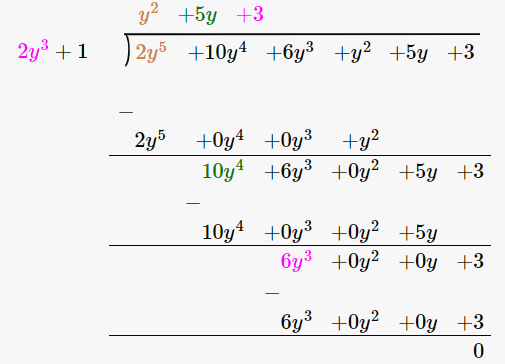
∴ (2y5 + 10y4 + 6y3 + y2 + 5y + 3) / (2y3 + 1) = y2 + 5y + 3
12. x4 – 2x3 + 2x2 + x + 4 by x2 + x + 1
Solution:
We have,
(x4 – 2x3 + 2x2 + x + 4) / (x2 + x + 1)
By using long division method

∴ (x4 – 2x3 + 2x2 + x + 4) / (x2 + x + 1) = x2 – 3x + 4
13. m3 – 14m2 + 37m – 26 by m2 – 12m + 13
Solution:
We have,
(m3 – 14m2 + 37m – 26) / (m2 – 12m + 13)
By using long division method
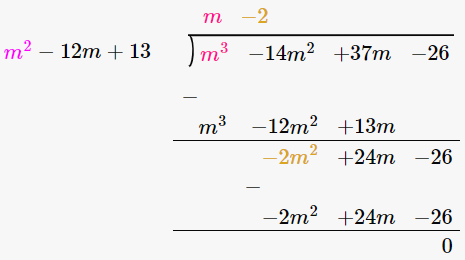
∴ (m3 – 14m2 + 37m – 26) / (m2 – 12m + 13) = m – 2
14. x4 + x2 + 1 by x2 + x + 1
Solution:
We have,
(x4 + x2 + 1) / (x2 + x + 1)
By using long division method

∴ (x4 + x2 + 1) / (x2 + x + 1) = x2 – x + 1
15. x5 + x4 + x3 + x2 + x + 1 by x3 + 1
Solution:
We have,
(x5 + x4 + x3 + x2 + x + 1) / (x3 + 1)
By using long division method

∴ (x5 + x4 + x3 + x2 + x + 1) / (x3 + 1) = x2 + x + 1
Divide each of the following and find the quotient and remainder:
16. 14x3 – 5x2 + 9x – 1 by 2x – 1
Solution:
We have,
(14x3 – 5x2 + 9x – 1) / (2x – 1)
By using long division method
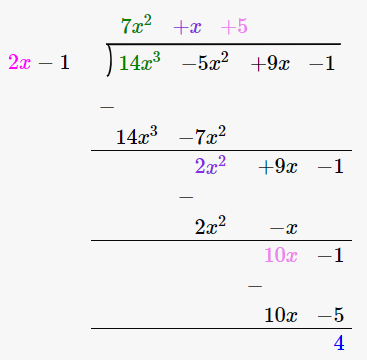
∴ Quotient is 7x2 + x + 5 and the Remainder is 4.
17. 6x3 – x2 – 10x – 3 by 2x – 3
Solution:
We have,
(6x3 – x2 – 10x – 3) / (2x – 3)
By using long division method
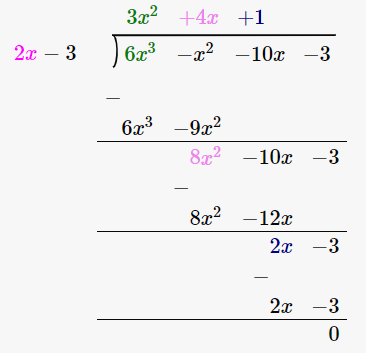
∴ Quotient is 3x2 + 4x + 1 and the Remainder is 0.
18. 6x3 + 11x2 – 39x – 65 by 3x2 + 13x + 13
Solution:
We have,
(6x3 + 11x2 – 39x – 65) / (3x2 + 13x + 13)
By using long division method

∴ Quotient is 2x – 5 and the Remainder is 0.
19. 30x4 + 11x3 – 82x2 – 12x + 48 by 3x2 + 2x – 4
Solution:
We have,
(30x4 + 11x3 – 82x2 – 12x + 48) / (3x2 + 2x – 4)
By using long division method

∴ Quotient is 10x2 – 3x – 12 and the Remainder is 0.
20. 9x4 – 4x2 + 4 by 3x2 – 4x + 2
Solution:
We have,
(9x4 – 4x2 + 4) / (3x2 – 4x + 2)
By using long division method

∴ Quotient is 3x2 + 4x + 2 and the Remainder is 0.
21. Verify division algorithm i.e. Dividend = Divisor × Quotient + Remainder, in each of the following. Also, write the quotient and remainder:
Dividend divisor
(i) 14x2 + 13x – 15 7x – 4
(ii) 15z3 – 20z2 + 13z – 12 3z – 6
(iii) 6y5 – 28y3 + 3y2 + 30y – 9 2x2 – 6
(iv) 34x – 22x3 – 12x4 – 10x2 – 75 3x + 7
(v) 15y4 – 16y3 + 9y2 – 10/3y + 6 3y – 2
(vi) 4y3 + 8y + 8y2 + 7 2y2 – y + 1
(vii) 6y4 + 4y4 + 4y3 + 7y2 + 27y + 6 2y3 + 1
Solution:
(i) Dividend divisor
14x2 + 13x – 15 7x – 4
By using long division method

Let us verify, Dividend = Divisor × Quotient + Remainder
14x2 + 13x – 15 = (7x – 4) × (2x + 3) + (-3)
= 14x2 + 21x – 8x -12 -3
= 14x2 + 13x – 15
Hence, verified.
∴ Quotient is 2x + 3 and the Remainder is -3.
(ii) Dividend divisor
15z3 – 20z2 + 13z – 12 3z – 6
By using long division method

Let us verify, Dividend = Divisor × Quotient + Remainder
15z3 – 20z2 + 13z – 12 = (3z – 6) × (5z2 + 10z/3 + 11) + 54
= 15z3 + 10z2 + 33z – 30z2 – 20z + 54
= 15z2 – 20z2 + 13z – 12
Hence, verified.
∴ Quotient is 5z2 + 10z/3 + 11 and the Remainder is 54.
(iii) Dividend divisor
6y5 – 28y3 + 3y2 + 30y – 9 2x2 – 6
By using long division method
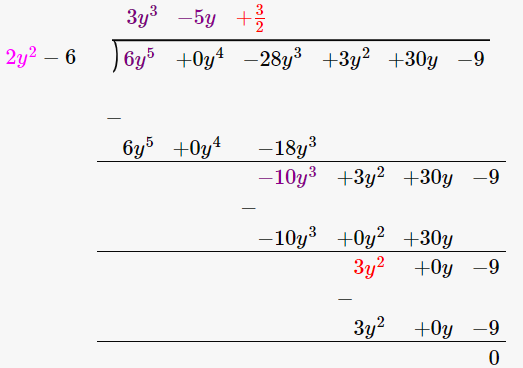
Let us verify, Dividend = Divisor × Quotient + Remainder
6y5 – 28y3 + 3y2 + 30y – 9 = (2x2 – 6) × (3y3 – 5y + 3/2) + 0
= 6y5 – 10y3 + 3y2 – 18y3 + 30y – 9
= 6y5 – 28y3 + 3y2 + 30y – 9
Hence, verified.
∴ Quotient is 3y3 – 5y + 3/2 and the Remainder is 0.
(iv) Dividend divisor
34x – 22x3 – 12x4 – 10x2 – 75 3x + 7
-12x4 – 22x3 – 10x2 + 34x – 75
By using long division method

Let us verify, Dividend = Divisor × Quotient + Remainder
-12x4 – 22x3 – 10x2 + 34x – 75 = (3x + 7) × (-4x3 + 2x2 – 8x + 30) – 285
= -12x4 + 6x3 – 24x2 – 28x3 + 14x2 + 90x – 56x + 210 -285
= -12x4 – 22x3 – 10x2 + 34x – 75
Hence, verified.
∴ Quotient is -4x3 + 2x2 – 8x + 30 and the Remainder is -285.
(v) Dividend divisor
15y4 – 16y3 + 9y2 – 10/3y + 6 3y – 2
By using long division method
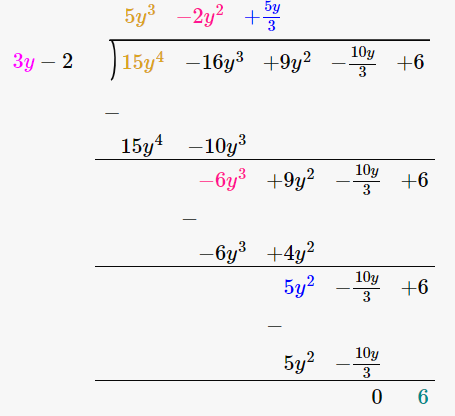
Let us verify, Dividend = Divisor × Quotient + Remainder
15y4 – 16y3 + 9y2 – 10/3y + 6 = (3y – 2) × (5y3 – 2y2 + 5y/3) + 6
= 15y4 – 6y3 + 5y2 – 10y3 + 4y2 – 10y/3 + 6
= 15y4 – 16y3 + 9y2 – 10/3y + 6
Hence, verified.
∴ Quotient is 5y3 – 2y2 + 5y/3 and the Remainder is 6.
(vi) Dividend divisor
4y3 + 8y + 8y2 + 7 2y2 – y + 1
4y3 + 8y2 + 8y + 7
By using long division method

Let us verify, Dividend = Divisor × Quotient + Remainder
4y3 + 8y2 + 8y + 7 = (2y2 – y + 1) × (2y + 5) + 11y + 2
= 4y3 + 10y2 – 2y2 – 5y + 2y + 5 + 11y + 2
= 4y3 + 8y2 + 8y + 7
Hence, verified.
∴ Quotient is 2y + 5 and the Remainder is 11y + 2.
(vii) Dividend divisor
6y5 + 4y4 + 4y3 + 7y2 + 27y + 6 2y3 + 1
By using long division method

Let us verify, Dividend = Divisor × Quotient + Remainder
6y5 + 4y4 + 4y3 + 7y2 + 27y + 6 = (2y3 + 1) × (3y2 + 2y + 2) + 4y2 + 25y + 4
= 6y5 + 4y4 + 4y3 + 3y2 + 2y + 2 + 4y2 + 25y + 4
= 6y5 + 4y4 + 4y3 + 7y2 + 27y + 6
Hence, verified.
∴ Quotient is 3y2 + 2y + 2 and the Remainder is 4y2 + 25y + 4.
22. Divide 15y4+ 16y3 + 10/3y – 9y2 – 6 by 3y – 2 Write down the coefficients of the terms in the quotient.
Solution:
We have,
(15y4+ 16y3 + 10/3y – 9y2 – 6) / (3y – 2)
By using long division method

∴ Quotient is 5y3 + 26y2/3 + 25y/9 + 80/27
So the coefficients of the terms in the quotient are:
Coefficient of y3 = 5
Coefficient of y2 = 26/3
Coefficient of y = 25/9
Constant term = 80/27
23. Using division of polynomials state whether
(i) x + 6 is a factor of x2 – x – 42
(ii) 4x – 1 is a factor of 4x2 – 13x – 12
(iii) 2y – 5 is a factor of 4y4 – 10y3 – 10y2 + 30y – 15
(iv) 3y2 + 5 is a factor of 6y5 + 15y4 + 16y3 + 4y2 + 10y – 35
(v) z2 + 3 is a factor of z5 – 9z
(vi) 2x2 – x + 3 is a factor of 6x5 – x4 + 4x3 – 5x2 – x – 15
Solution:
(i) x + 6 is a factor of x2 – x – 42
Firstly let us perform long division method

Since the remainder is 0, we can say that x + 6 is a factor of x2 – x – 42
(ii) 4x – 1 is a factor of 4x2 – 13x – 12
Firstly let us perform long division method

Since the remainder is -15, 4x – 1 is not a factor of 4x2 – 13x – 12
(iii) 2y – 5 is a factor of 4y4 – 10y3 – 10y2 + 30y – 15
Firstly let us perform long division method

Since the remainder is 5y3 – 45y2/2 + 30y – 15, 2y – 5 is not a factor of 4y4 – 10y3 – 10y2 + 30y – 15
(iv) 3y2 + 5 is a factor of 6y5 + 15y4 + 16y3 + 4y2 + 10y – 35
Firstly let us perform long division method

Since the remainder is 0, 3y2 + 5 is a factor of 6y5 + 15y4 + 16y3 + 4y2 + 10y – 35
(v) z2 + 3 is a factor of z5 – 9z
Firstly let us perform long division method

Since the remainder is 0, z2 + 3 is a factor of z5 – 9z
(vi) 2x2 – x + 3 is a factor of 6x5 – x4 + 4x3 – 5x2 – x – 15
Firstly let us perform long division method
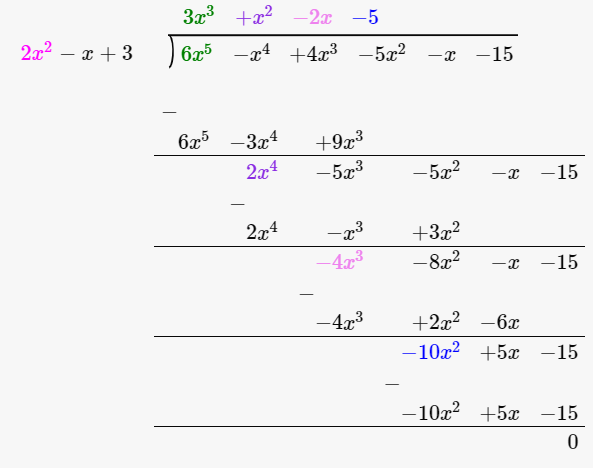
Since the remainder is 0, 2x2 – x + 3 is a factor of 6x5 – x4 + 4x3 – 5x2 – x – 15
24. Find the value of a, if x + 2 is a factor of 4x4 + 2x3 – 3x2 + 8x + 5a
Solution:
We know that x + 2 is a factor of 4x4 + 2x3 – 3x2 + 8x + 5a
Let us equate x + 2 = 0
x = -2
Now let us substitute x = -2 in the equation 4x4 + 2x3 – 3x2 + 8x + 5a
4(-2)4 + 2(-2)3 – 3(-2)2 + 8(-2) + 5a = 0
64 – 16 – 12 – 16 + 5a = 0
20 + 5a = 0
5a = -20
a = -20/5
= -4
25. What must be added to x4 + 2x3 – 2x2 + x – 1 so that the resulting polynomial is exactly divisible by x2 + 2x -3.
Solution:
Firstly let us perform long division method

By long division method we got remainder as –x + 2,
∴ x – 2 has to be added to x4 + 2x3 – 2x2 + x – 1 so that the resulting polynomial is exactly divisible by x2 + 2x -3.
EXERCISE 8.5 PAGE NO: 8.15
1. Divide the first polynomial by the second polynomial in each of the following. Also, write the quotient and remainder:
(i) 3x2 + 4x + 5, x – 2
(ii) 10x2 – 7x + 8, 5x – 3
(iii) 5y3 – 6y2 + 6y – 1, 5y – 1
(iv) x4 – x3 + 5x, x – 1
(v) y4 + y2, y2 – 2
Solution:
(i) 3x2 + 4x + 5, x – 2
By using long division method

∴ the Quotient is 3x + 10 and the Remainder is 25.
(ii) 10x2 – 7x + 8, 5x – 3
By using long division method

∴ the Quotient is 2x – 1/5 and the Remainder is 37/5.
(iii) 5y3 – 6y2 + 6y – 1, 5y – 1
By using long division method
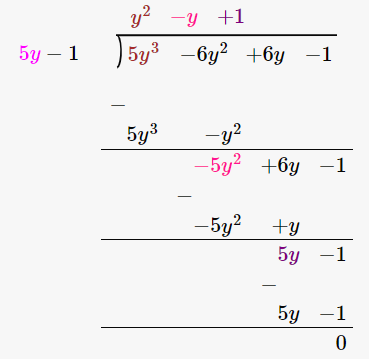
∴ the Quotient is y2 – y + 1 and the Remainder is 0.
(iv) x4 – x3 + 5x, x – 1
By using long division method
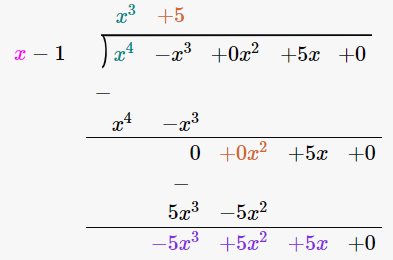
∴ the Quotient is x3 + 5 and the Remainder is 5.
(v) y4 + y2, y2 – 2
By using long division method
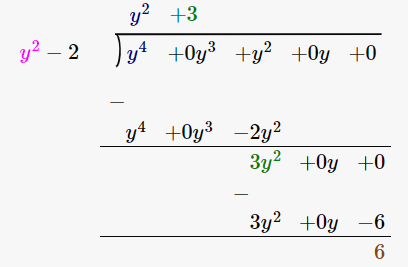
∴ the Quotient is y2 + 3 and the Remainder is 6.
2. Find Whether or not the first polynomial is a factor of the second:
(i) x + 1, 2x2 + 5x + 4
(ii) y – 2, 3y3 + 5y2 + 5y + 2
(iii) 4x2 – 5, 4x4 + 7x2 + 15
(iv) 4 – z, 3z2 – 13z + 4
(v) 2a – 3, 10a2 – 9a – 5
(vi) 4y + 1, 8y2 – 2y + 1
Solution:
(i) x + 1, 2x2 + 5x + 4
Let us perform long division method,

Since remainder is 1 therefore the first polynomial is not a factor of the second polynomial.
(ii) y – 2, 3y3 + 5y2 + 5y + 2
Let us perform long division method,
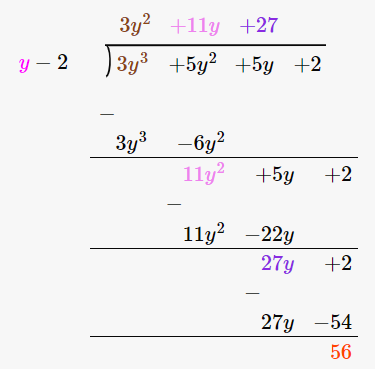
Since remainder is 56 therefore the first polynomial is not a factor of the second polynomial.
(iii) 4x2 – 5, 4x4 + 7x2 + 15
Let us perform long division method,
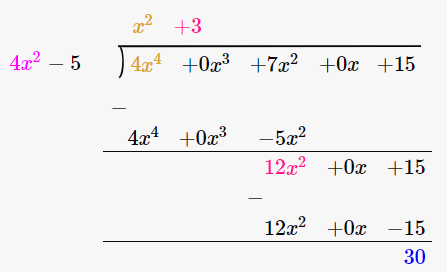
Since remainder is 30 therefore the first polynomial is not a factor of the second polynomial.
(iv) 4 – z, 3z2 – 13z + 4
Let us perform long division method,

Since remainder is 0 therefore the first polynomial is a factor of the second polynomial.
(v) 2a – 3, 10a2 – 9a – 5
Let us perform long division method,
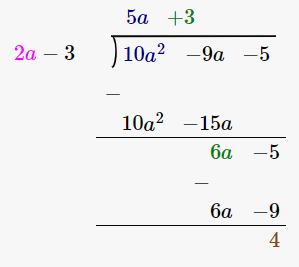
Since remainder is 4 therefore the first polynomial is not a factor of the second polynomial.
(vi) 4y + 1, 8y2 – 2y + 1
Let us perform long division method,

Since remainder is 2 therefore the first polynomial is not a factor of the second polynomial.
EXERCISE 8.6 PAGE NO: 8.17
Divide:
1. x2 – 5x + 6 by x – 3
Solution:
We have,
(x2 – 5x + 6) / (x – 3)
Let us perform long division method,

∴ the Quotient is x – 2
2. ax2 – ay2 by ax+ay
Solution:
We have,
(ax2 – ay2)/ (ax+ay)
(ax2 – ay2)/ (ax+ay) = (x – y) + 0/(ax+ay)
= (x – y)
∴ the answer is (x – y)
3. x4 – y4 by x2 – y2
Solution:
We have,
(x4 – y4)/ (x2 – y2)
(x4 – y4)/ (x2 – y2) = x2 + y2 + 0/(x2 – y2)
= x2 + y2
∴ the answer is (x2 + y2)
4. acx2 + (bc + ad)x + bd by (ax + b)
Solution:
We have,
(acx2 + (bc + ad) x + bd) / (ax + b)
(acx2 + (bc + ad) x + bd) / (ax + b) = cx + d + 0/ (ax + b)
= cx + d
∴ the answer is (cx + d)
5. (a2 + 2ab + b2) – (a2 + 2ac + c2) by 2a + b + c
Solution:
We have,[(a2 + 2ab + b2) – (a2 + 2ac + c2)] / (2a + b + c)[(a2 + 2ab + b2) – (a2 + 2ac + c2)] / (2a + b + c) = b – c + 0/(2a + b + c)
= b – c
∴ the answer is (b – c)
6. 1/4x2 – 1/2x – 12 by 1/2x – 4
Solution:
We have,
(1/4x2 – 1/2x – 12) / (1/2x – 4)
Let us perform long division method,
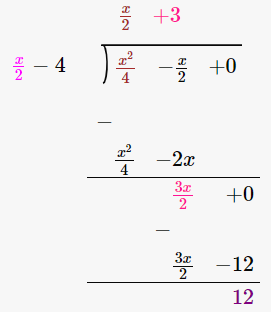
∴ the Quotient is x/2 + 3
RD Sharma Solutions for Class 8 Maths Chapter 8: Download PDF
RD Sharma Solutions for Class 8 Maths Chapter 8–Division of Algebraic Expressions
Download PDF: RD Sharma Solutions for Class 8 Maths Chapter 8–Division of Algebraic Expressions PDF
Chapterwise RD Sharma Solutions for Class 8 Maths :
- Chapter 1–Rational Numbers
- Chapter 2–Powers
- Chapter 3–Squares and Square Roots
- Chapter 4–Cubes and Cube Roots
- Chapter 5–Playing with Numbers
- Chapter 6–Algebraic Expressions and Identities
- Chapter 7–Factorization
- Chapter 8–Division of Algebraic Expressions
- Chapter 9–Linear Equation in One Variable
- Chapter 10–Direct and Inverse Variations
- Chapter 11–Time and Work
- Chapter 12–Percentage
- Chapter 13–Profit, Loss, Discount and Value Added Tax (VAT)
- Chapter 14–Compound Interest
- Chapter 15–Understanding Shapes- I (Polygons)
- Chapter 16–Understanding Shapes- II (Quadrilaterals)
- Chapter 17–Understanding Shapes- III (Special Types of Quadrilaterals)
- Chapter 18–Practical Geometry (Constructions)
- Chapter 19–Visualising Shapes
- Chapter 20–Mensuration – I (Area of a Trapezium and a Polygon)
- Chapter 21–Mensuration – II (Volumes and Surface Areas of a Cuboid and a cube)
- Chapter 22–Mensuration – III (Surface Area and Volume of a Right Circular Cylinder)
- Chapter 23–Data Handling – I (Classification and Tabulation of Data)
- Chapter 24–Data Handling – II (Graphical Representation of Data as Histogram)
- Chapter 25–Data Handling – III (Pictorial Representation of Data as Pie Charts or Circle Graphs)
- Chapter 26–Data Handling – IV (Probability)
- Chapter 27–Introduction to Graphs
About RD Sharma
RD Sharma isn’t the kind of author you’d bump into at lit fests. But his bestselling books have helped many CBSE students lose their dread of maths. Sunday Times profiles the tutor turned internet star
He dreams of algorithms that would give most people nightmares. And, spends every waking hour thinking of ways to explain concepts like ‘series solution of linear differential equations’. Meet Dr Ravi Dutt Sharma — mathematics teacher and author of 25 reference books — whose name evokes as much awe as the subject he teaches. And though students have used his thick tomes for the last 31 years to ace the dreaded maths exam, it’s only recently that a spoof video turned the tutor into a YouTube star.
R D Sharma had a good laugh but said he shared little with his on-screen persona except for the love for maths. “I like to spend all my time thinking and writing about maths problems. I find it relaxing,” he says. When he is not writing books explaining mathematical concepts for classes 6 to 12 and engineering students, Sharma is busy dispensing his duty as vice-principal and head of department of science and humanities at Delhi government’s Guru Nanak Dev Institute of Technology.
